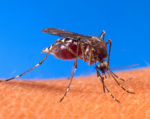Difference between revisions of "Culicidae"
Jump to navigation
Jump to search
| (23 intermediate revisions by 2 users not shown) | |||
| Line 1: | Line 1: | ||
| − | + | ==Introduction== | |
| − | { | + | {| cellpadding="10" cellspacing="0" border="1" |
| − | | | + | | Also known as: |
| − | | | + | | '''Mosquitoes |
| − | | | + | |- |
| − | | | + | |DO NOT CONFUSE WITH |
| − | | | + | |[[Ceratopogonidae|''Culicoides midges'']] |
| − | | | + | |- |
| − | + | |} | |
| − | + | [[Image:Aedes aegypti.jpg|thumb|right|150px|''Aeges aegypti'' - Wikimedia Commons]] | |
| − | + | ||
| − | + | *Found worldwide | |
| − | + | ||
| − | + | *Attack a wide variety of animals including humans | |
| − | + | ||
| − | + | *The most important species of veterinary importance are | |
| − | + | **''Culex'' | |
| − | + | **''Aedes'' | |
| − | + | **''Anopheles'' | |
| + | |||
| + | |||
| + | '''Recognition''' | ||
| + | *Small flies 2-10mm long | ||
| + | |||
| + | *Forward pointing proboscis | ||
| − | + | *Slender body and long legs | |
| − | + | *Narrow wings | |
| − | + | ||
| + | *Veins and rear margins of wings fringed with scales | ||
| + | |||
| + | |||
| + | '''Life cycle''' | ||
| + | *Eggs laid on water | ||
| + | **Either laid singly or in rafts | ||
| + | |||
| + | *Larval and pupal stages are aquatic | ||
| + | **Visible hanging from the water surface | ||
| + | |||
| + | *Life cycle takes '''2 weeks to several months''' to complete | ||
| + | **Temperature dependent | ||
| + | |||
| + | |||
| + | '''Pathogenesis''' | ||
| + | *Most active at night | ||
| − | + | *Painful, irritating bites | |
| − | * | + | **Only females suck blood |
| − | * | ||
| − | * | ||
| − | + | *Transmit human diseases | |
| − | + | **Viruses such as dengue fever, encephalitis and yellow fever | |
| + | **Parasites such as malaria caused by ''Plasmodium'' and filarial nematodes which cause elephantosis (''Wuchereria and Brugia'') | ||
| − | + | *Transmit animal diseases | |
| − | + | **Viruses such as arbovirus which causes [[Equine Encephalitis Virus|equine encephalitis]] and [[Myxomatosis|rabbit myxomatosis]] | |
| − | + | **Parasites such as the [[Dirofilaria immitis|canine heartworm]], ''Dirofilaria immitis'' and avian malaria caused by ''Plasmodium'' | |
| − | |||
| − | |||
| − | |||
| − | ''' | ||
| − | |||
| − | |||
| − | |||
| − | |||
| − | |||
| − | + | '''Control''' | |
| − | + | *Destroy breeding sites by drainage and removal of objects which collect water | |
| − | |||
| + | *Repeat applications of [[Ectoparasiticides|insecticides]] | ||
| + | **Synthetic pyrethroids sprayed from helicopters | ||
| + | **Mineral oils applied to breeding sites | ||
| − | + | *Education | |
| − | + | *Future control methods being developed, such as genetic engineering and biological control methods | |
[[Category:Biting_Flies]] | [[Category:Biting_Flies]] | ||
| − | [[Category: | + | [[Category:To_Do_-_Parasites]] |
| + | [[Category:To_Do_-_Workshop]] | ||
Revision as of 10:01, 30 June 2010
Introduction
| Also known as: | Mosquitoes |
| DO NOT CONFUSE WITH | Culicoides midges |
- Found worldwide
- Attack a wide variety of animals including humans
- The most important species of veterinary importance are
- Culex
- Aedes
- Anopheles
Recognition
- Small flies 2-10mm long
- Forward pointing proboscis
- Slender body and long legs
- Narrow wings
- Veins and rear margins of wings fringed with scales
Life cycle
- Eggs laid on water
- Either laid singly or in rafts
- Larval and pupal stages are aquatic
- Visible hanging from the water surface
- Life cycle takes 2 weeks to several months to complete
- Temperature dependent
Pathogenesis
- Most active at night
- Painful, irritating bites
- Only females suck blood
- Transmit human diseases
- Viruses such as dengue fever, encephalitis and yellow fever
- Parasites such as malaria caused by Plasmodium and filarial nematodes which cause elephantosis (Wuchereria and Brugia)
- Transmit animal diseases
- Viruses such as arbovirus which causes equine encephalitis and rabbit myxomatosis
- Parasites such as the canine heartworm, Dirofilaria immitis and avian malaria caused by Plasmodium
Control
- Destroy breeding sites by drainage and removal of objects which collect water
- Repeat applications of insecticides
- Synthetic pyrethroids sprayed from helicopters
- Mineral oils applied to breeding sites
- Education
- Future control methods being developed, such as genetic engineering and biological control methods
